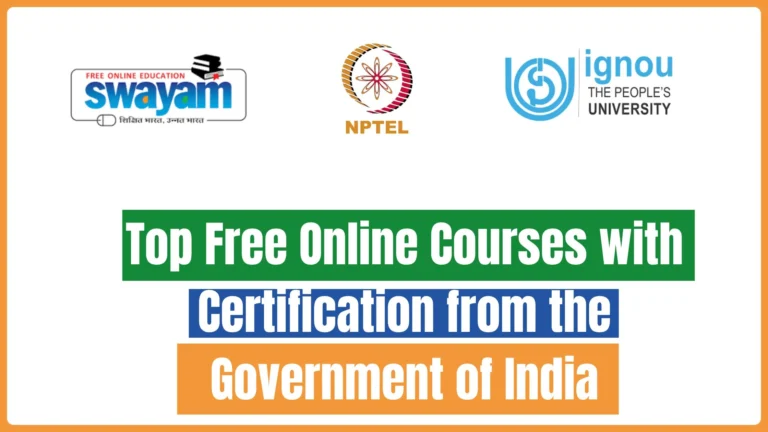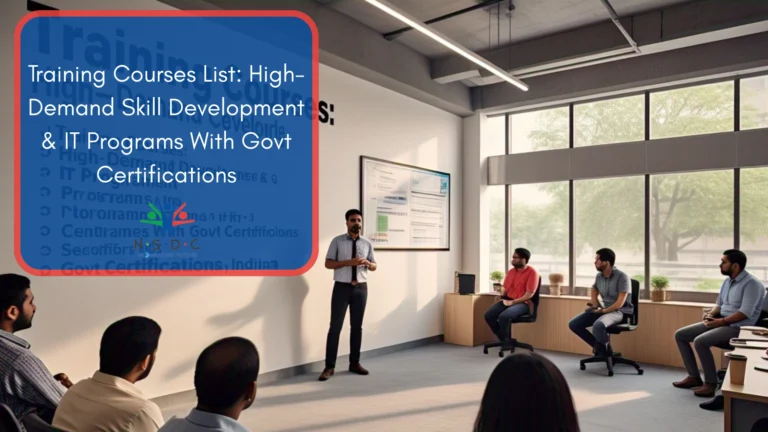The Ultimate Guide to Government Vocational Training Programs in India
Introduction: Building a Skilled India, One Trainee at a Time
In a nation as vast and dynamic as India, the bridge between education and employment is built on the robust foundation of vocational training programs. These programs are designed to equip individuals with specific, practical skills tailored to the needs of various industries, moving beyond theoretical knowledge to hands-on expertise. Recognizing the critical role of skilling in economic growth and individual empowerment, the Government of India has established a massive network of government vocational training institutes and schemes, making quality skill development accessible to millions.
This definitive pillar page serves as your complete guide to navigating this ecosystem. Whether you are a student looking for a practical career path, a professional seeking to upskill, or simply curious about govt vocational training institute options, this resource will provide you with everything you need to know. We will explore the flagship schemes, the types of courses available, the benefits of government-certified training, and provide a clear roadmap on how to enroll in a program that can transform your career prospects.
1. What are Vocational Training Programs? Definition and Importance
Vocational training programs, also known as technical education or career and technical education (CTE), are instructional programs that focus on providing individuals with the skills and knowledge required for a specific trade, craft, or job function. Unlike traditional academic education, which is often broad and theoretical, vocational training is practical, hands-on, and directly aligned with the needs of employers.
The importance of these programs cannot be overstated:
- Bridges the Skills Gap: They directly address the mismatch between the skills job seekers possess and the skills employers need.
- Enhances Employability: Graduates are “job-ready” from day one, reducing the time and cost companies spend on training new hires.
- Promotes Economic Growth: A skilled workforce is a primary driver of industrial productivity and economic development.
- Provides Accessible Education: They offer an excellent alternative to conventional degree programs, often with shorter durations and lower costs, making quality education accessible to a wider population.
Government vocational training programs specifically are crucial because they ensure standardization, quality, and affordability, often providing training free of cost or at a highly subsidized rate.
2. The Architecture of Government Vocational Training in India
The Indian government vocational skilling ecosystem is a well-structured network involving multiple ministries and organizations.
2.1. Key Governing Bodies: MSDE, DGT, and NSDC
- Ministry of Skill Development and Entrepreneurship (MSDE): This is the apex body responsible for coordinating all skill development efforts across the country. It oversees the overall policy, planning, and implementation of vocational training programs.
- Directorate General of Training (DGT): Operating under the MSDE, the DGT is the nodal authority for formulating policies and programs for vocational training. It manages the vast network of Industrial Training Institutes (ITIs) and Advanced Training Institutes (ATIs).
- National Skill Development Corporation (NSDC): A public-private partnership (PPP) that aims to promote skill development by funding vocational training initiatives, enabling support systems, and fostering private sector participation. It is a key implementing agency for schemes like PMKVY.
2.2. Types of Government Vocational Training Institutes
The government operates various types of institutes catering to different levels of skilling:
- Industrial Training Institutes (ITIs): These are the most prolific govt vocational training institute centers. They offer long-term courses (1-2 years) in engineering and non-engineering trades, culminating in a National Trade Certificate (NTC).
- Industrial Training Centers (ITCs): Private institutions affiliated with the DGT that offer courses similar to ITIs.
- Pradhan Mantri Kaushal Kendras (PMKKs): Model training centers with state-of-the-art infrastructure established under the PMKVY scheme to provide high-quality short-term training.
- National Skill Training Institutes (NSTIs): Formerly known as Advanced Training Institutes (ATIs), these offer advanced and specialized training for instructors and technicians.
- Polytechnics: These institutes offer three-year diploma courses in various engineering and technology disciplines, a step above ITI training.
3. Flagship Government Vocational Training Schemes
3.1. Industrial Training Institutes (ITIs) – The Backbone of Vocational Training
ITIs are the cornerstone of India’s formal vocational training infrastructure.
- Courses: They offer training in over 130 trades, such as Electrician, Fitter, Welder, Computer Operator and Programming Assistant (COPA), Mechanic (Motor Vehicle), and Draughtsman (Civil/Mechanical).
- Certification: Successful candidates receive the National Trade Certificate (NTC) from the National Council for Vocational Training (NCVT), which is recognized nationwide.
- Admission: Admission is typically based on merit in the 10th or 8th standard exams, and each state conducts its own centralized entrance exam for ITI admissions.
3.2. Pradhan Mantri Kaushal Vikas Yojana (PMKVY) – Short-Term Skill Development
PMKVY is the flagship scheme for providing free, short-term skill development training.
- Objective: To enable a large number of Indian youth to take up industry-relevant skill training that will help them in securing a better livelihood.
- Training: Provides short-duration training (150 to 300 hours) based on National Occupational Standards (NOS).
- Recognition of Prior Learning (RPL): certifies individuals with existing skills or experience.
- Financial Reward: Candidates are eligible for a monetary reward upon successful completion of assessment and placement.
3.3. National Apprenticeship Promotion Scheme (NAPS) – Earn While You Learn
NAPS promotes apprenticeship training in the country.
- Model: It provides on-the-job training (OJT) to apprentices in various industries. The cost is shared between the government and the employers.
- Benefit: Apprentices receive a stipend during their training period, allowing them to “earn while they learn” and gain invaluable industry experience.
- Portal: The entire process of engaging apprentices is managed through an online portal.
4. Vocational Training Courses List: Sectors and Opportunities
Government vocational training programs cover a wide spectrum of sectors. Here is a non-exhaustive list:
| Sector | Examples of Trades/Courses | Typical Institute |
|---|---|---|
| Engineering | Fitter, Electrician, Turner, Machinist, Welder | ITI, NSTI |
| Construction | Mason, Plumber, Carpenter, Surveyor | ITI, PMKVY Centers |
| IT & Telecom | COPA, Dot Net Developer, Network Technician | ITI, PMKVY Centers, NSTI |
| Beauty & Wellness | Beauty Therapist, Hair Stylist, Makeup Artist | PMKVY Centers, ITI (some states) |
| Healthcare | General Duty Assistant, Medical Lab Technician | PMKVY Centers, Polytechnic |
| Hospitality | Food & Beverage Service, Chef, Housekeeping | ITI, PMKVY Centers |
| Automotive | Mechanic (Motor Vehicle), Auto Body Repair | ITI, PMKVY Centers |
| Retail | Retail Sales Associate, Store Operations | PMKVY Centers |
5. How to Find and Join a Government Vocational Training Institute
5.1. Eligibility Criteria
Eligibility varies by scheme and course:
- ITIs: Typically require a minimum of passing Class 8 or Class 10, depending on the trade.
- PMKVY: Open to any Indian youth who is either unemployed, a school/college dropout, or looking to learn a new skill. Specific age criteria (e.g., 15-45 years) may apply.
- NAPS: The minimum age is 14 years, and the person must meet the minimum educational qualification prescribed for the trade.
5.2. Application Process and Entrance Exams
- ITIs:
- Check the official state ITI admission website.
- Register for the state-level entrance exam (if applicable).
- Participate in counseling and seat allotment based on rank.
- PMKVY:
- Visit the official Skill India or PMKVY portal.
- Use the “Find a Training Centre” feature.
- Locate a nearby approved centre and contact them directly for registration.
- NAPS:
- Candidates can register on the apprenticeship portal.
- Employers also list opportunities on the portal for candidates to apply.
6. Benefits of Enrolling in a Government Vocational Program
- Cost-Effective: Training is often free or highly subsidized by the government.
- Industry-Recognized Certification: Certificates from NCVT, SCVT, or under PMKVY are valued by employers nationwide.
- High Employability: The curriculum is designed as per industry needs, leading to excellent placement opportunities.
- Practical Learning: The focus is on hands-on training, ensuring you are job-ready.
- Placement Assistance: Most government institutes and schemes have dedicated placement cells.
7. Conclusion: Your Pathway to a Skilled and Secure Future
Government vocational training programs offer a viable, respectable, and highly effective pathway to a successful and secure career. They represent a strategic investment in your future, empowering you with the practical skills that industries actively seek. By choosing to enroll in a govt vocational training institute, you are not just learning a trade; you are becoming a part of India’s core skilled workforce, driving both your personal growth and the nation’s economic engine. Take the first step today by exploring the schemes mentioned in this guide and embark on your journey to becoming a skilled professional.







